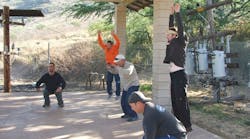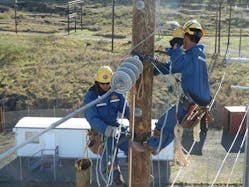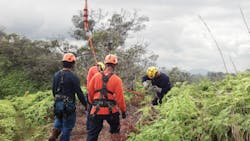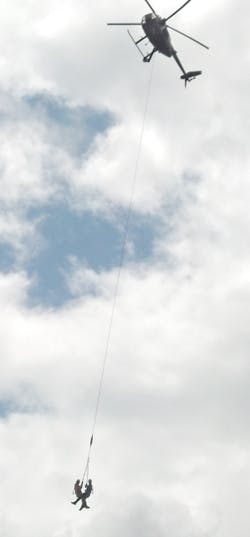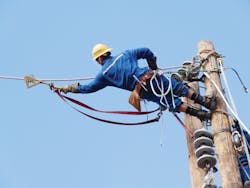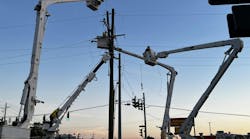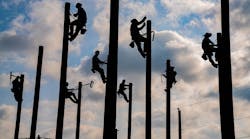Up until five years ago, linemen could free climb on Hawaiian Electric, Maui Electric or Hawaii Electric Light Co. structures and poles. With a shift in the companies’ safety cultures and after seeing other electric utilities invest in restraint devices for their linemen, however, the utilities opted to shift to 100% fall protection.
Following a visit to the International Lineman’s Rodeo, where many utilities were mandating fall protection for their linemen, Hawaiian Electric began searching for ways to keep its linemen safe in the field.
While it was challenging to get everyone on board at first, it has made a significant difference at the utility. In fact, over the last five years, Hawaiian Electric has not had any major fall-related injuries.
Rolling Out Fall Protection
To teach its linemen about fall protection, Hawaiian Electric invited the experts from the Northwest Lineman’s College to provide a demonstration. After looking at several different devices, the utility opted to invest in the BuckSqueeze from Buckingham Manufacturing. The linemen now wear this device when climbing individual poles and retractable lines, and lanyards when working on towers and other structures.
Hawaiian Electric then mandated fall protection by gaining acceptance for the device and the new safety practices from the bottom up. The utility first focused on training the apprentices and later got the journeymen linemen on board.
To begin implementing the full fall-protection program, a handful of journeymen volunteered to serve as trainers for the apprentices. With their help, Hawaiian Electric was able to get the newer climbers up to speed with a hands-on training course. To reach the rest of the journeymen, the utility visited job sites with the fall-protection devices and performed training in the field.
Journeymen found that one of the many benefits of fall-restraint devices included the safety of their new apprentice crew members. When the journeymen watched the new apprentices climb before the full fall protection was implemented, they had to watch them climb higher and higher, and just cross their fingers that there wouldn’t be an accident or fall.
The new fall-restraint device, however, helps protect apprentices while they are learning how to climb. If they do have an accident, they can cut out and will not get hurt. Also, the trainers don’t need to worry constantly when teaching them how to climb.
Training Apprentices Climbing Techniques
Hawaiian Electric offers a five-week climbing class that takes place three times a week. The course takes place after work so the apprentices learn how to climb on their own time. Hawaiian Electric trainers cover the fundamentals and the class is self-progressed. The students start off as low as 1 ft on the poles and then slowly progress 5 ft to 10 ft at a time. This allows the apprentices to master a particular height and gain confidence in their abilities before continuing on.
Along with working their way up and down the pole, the class members also practice framing arms and putting up insulators. The class is restricted to apprentices, and the trainers try to keep the students to below 50 ft on the 70-ft poles in the training yard. The utility has the apprentices watch a video on how to climb a pole step by step.
The Hawaiian Electric trainers also focus on physical conditioning because climbing can be very demanding. The utility includes a stretching routine, designed by CrossFit, before each class.
CrossFit is defined as that which optimizes fitness with constantly varied functional movements performed at relatively high intensity. CrossFit also focuses on community building that spontaneously arises when people do these workouts together. In fact, the communal aspect of CrossFit is a key component of why it is so effective.
This exercise regimen warms up the apprentices’ muscles and gets them limber before they begin their work. In the long run, the utility encourages the apprentices to have a healthy lifestyle as well as a safer work environment.
Adapting to New Technology
While the apprentices typically climb wood poles in the training yard, they are increasingly scaling fiberglass poles in the field. With the tropical weather, rain and termites on the island of Oahu, HECO is investing more in fiberglass poles and arms.
This type of technology offers many benefits. First of all, the fiberglass products are easier to transport because they are lightweight. Oftentimes, if the linemen need to replace an old pole behind a home, they need to carry it by hand. With the fiberglass pole, it’s easier to put the new pole into position.
In addition, the linemen are also relying on helicopters to work in remote areas. Fall protection is an important part of a work method called “short hauling,” in which linemen hang from a lifeline suspended from a helicopter. The helicopter pilot then drops off the linemen as close as possible to the structure.
With this work method, Hawaiian Electric doesn’t need to disturb environmentally protected forest areas in remote regions. Previously, if there was a pole that needed repair, the utility had to send in trimmers to cut trails and work areas to allow the crews to drive in their equipment and stage the work site.
Short hauling, however, completely eliminates the need to trim the trees and clear the area. Instead, the linemen can begin working right away, which saves time in the field. During this process, it’s essential for linemen to wear a harness and communicate with the pilots. Trust and teamwork are an important part of the job.
By mandating full fall protection and adapting to changing technology and work methods, the utility has been able to minimize fall-related injuries while improving productivity in the field. Like other linemen, Hawaiian Electric’s employees can no longer free climb on the system. Instead, they must wear harnesses at all times to ensure both safety and efficiency in the field.
Fred Kana’i Kauhane ([email protected]) has been with the Hawaiian Electric Co. Inc. for 25 years. He worked for 14 years as a lineman and spent four years in the trouble department before moving into management as a training supervisor for the construction and maintenance department.
Companies mentioned:
Buckingham Manufacturing Co. www.buckinghammfg.com
CrossFit Inc.| www.crossfit.com
Hawaiian Electric Co.| www.heco.com
